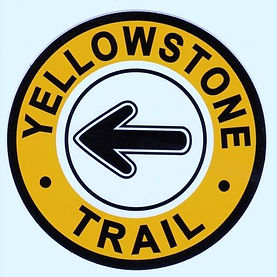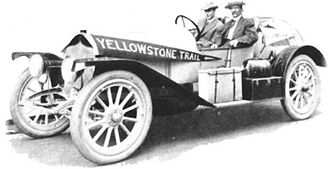Yellowstone Trail

The Yellowstone Trail was the first transcontinental automobile highway in the United States, stretching across the northern part of the country from Washington all the way to Massachusetts. But, few people are aware of its social, political and economic effects on the nation. Some, don't even realize it exists.
In 1912, there were no long distance roads. None that were useful anyway. There were few all weather roads and absolutely no government marked routes like you see today. Railroads were dominant, but they were losing their attraction because of their monopolistic freight rate-setting, inconvenient schedules, and the undeniable privacy and autonomy of the automobile.

The exploding number of automobile purchases resulted in a demand for roads to drive them on, not only for pleasure, but for crucial societal purposes like doctors being able to get to their patients, products to and from railroad stops, and military purposes. Enter J.W. Parmley of Ipswich, South Dakota.

Parmley and his fellow business colleagues wanted a road that would travel 25 miles from Ipswich to Aberdeen, South Dakota, that wasn't plagued with sand, potholes and mud. But, in just a few weeks time, the "can do" pioneer spirit emerged and the intent to build a "good road" had expanded to Mobridge, South Dakota, then to Hettinger, North Dakota, and then all the way to Yellowstone National Park. Soon enough, they realized that they would lay "a good road from Plymouth Rock to Puget Sound."
The Yellowstone Trail Association was formed in October of 1912. It was an organization composed of businessmen/Chamber of Commerce people, mostly in small towns who wanted to boost their local economy by being on the road. The Association never built the road, but it provided instructions to local
people for the construction/maintenance of roads, promote cross-country tourist traffic, marked the route of the trail and provided the first maps of the trail itself. The people of the local community would build the road. Picnics were held to make the "dragging" of the dirt road more fun and stores would close so everyone would participate. Usually, roads near The Chicago, Milwaukee, St. Paul and Pacific Railroads were chosen to be part of the trail because the railroads had already selected the most efficient routes. So, as one reads the history of the Yellowstone Trail, one reads the history of the Milwaukee Railroad.
Wisconsin became the first state to number its highways in 1918, and in 1926 the American Association of State Highway Officials (AASHO) established numbered interstate routes or "federal" highways. With these in place, named roads and their colored markers began to decrease. When the great depression came, people could no longer afford to pay dues to road associations. As a result the Yellowstone Trail, along with other popular named trails, lost their allure to the modern highways of 12, 29 or 10.
Through all of this, the Yellowstone Trail Association persisted. They publish maps and brochures that they hand out along busy places on the Trail and people telephone the Association every year to find out what parts of the road are still passable today so they can plan their trips. The new Yellowstone Trail Association was formed in October of 2003. Its purpose is to increase the public knowledge of the Trail, acquire information about the Trail and its historical context, preserve artifacts along the Trail, provide a medium of communication and support among members, and to promote heritage

tourism and sponsor Trail-related events. Today, the Association resembles the original in structure and its dependence on local members for celebratory events to succeed. Marking the Trail is a contemporary task, just as it was in 1912. Trail Days today does not involve working on the road as they did 110 years ago. Instead, picnics, entertainment and local Trail history celebrations are held.
This route is truly a national treasure. All of us at Powell County Museum & Arts Foundation and the Old Montana Prison & Auto Museum Complex are proud to be members of the Yellowstone Trail Association and being involved in keeping this amazing part of Montana and United States history alive!
.png)
.png)


